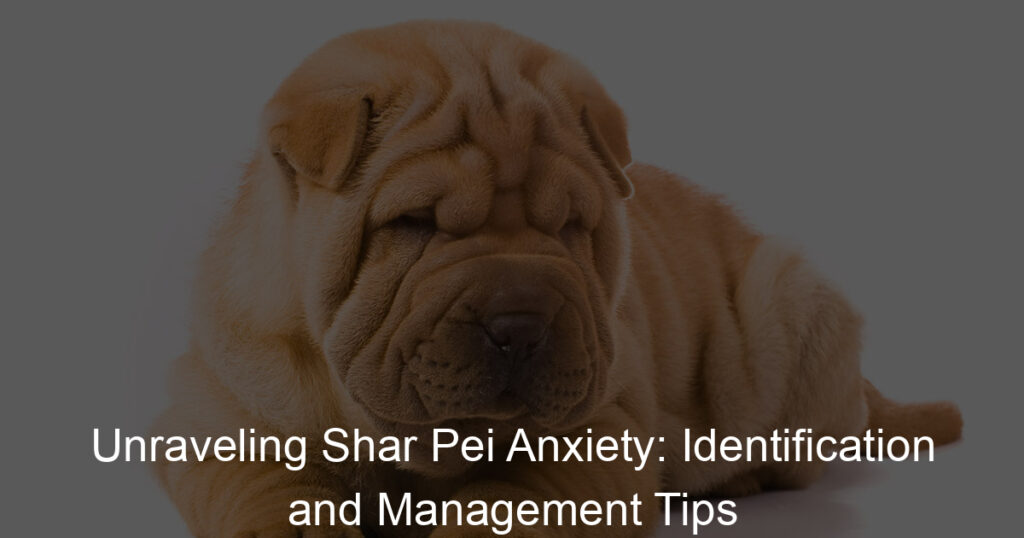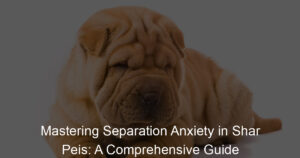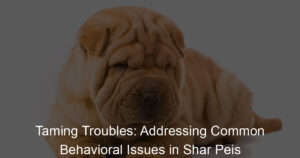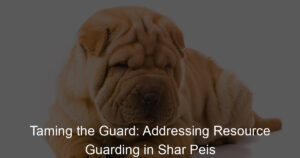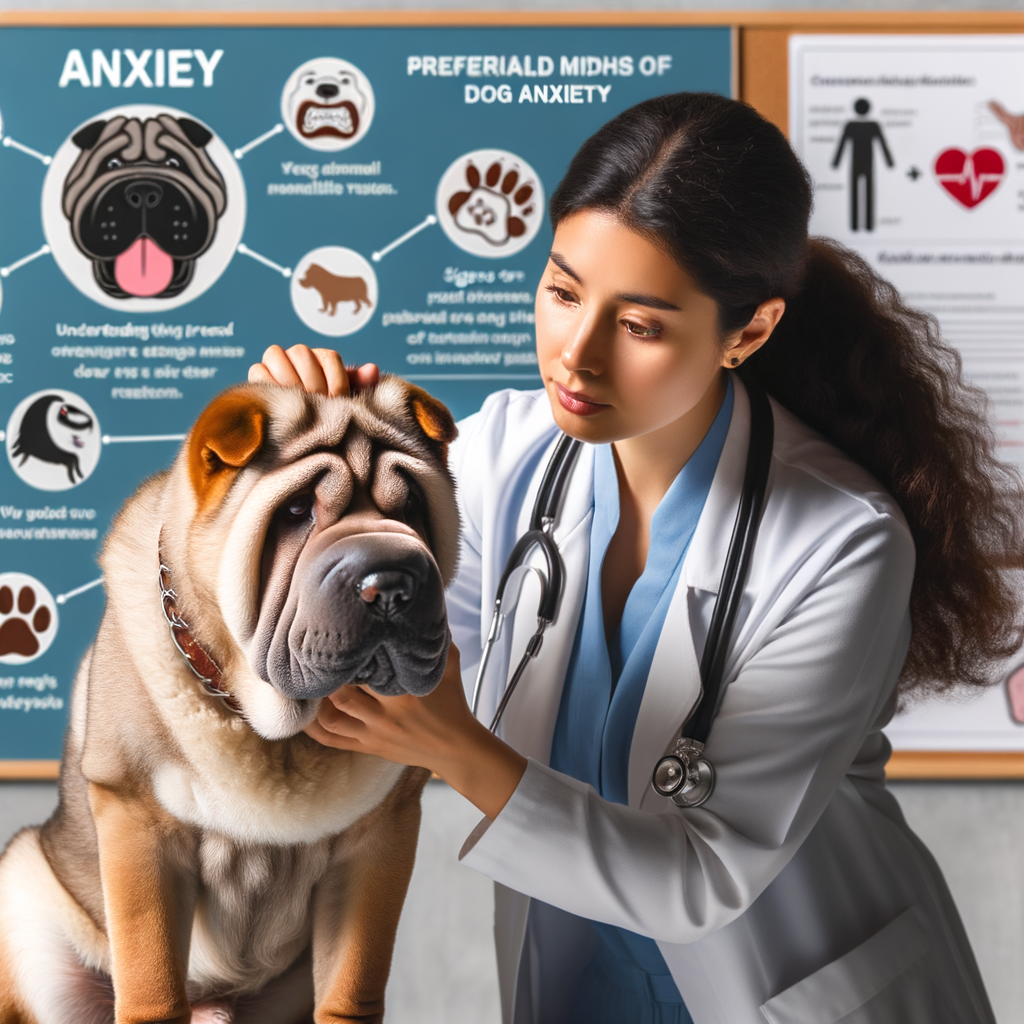
Introduction to Shar Pei Anxiety
Shar Pei dogs are known for their distinctive appearance and loyal nature. However, like all breeds, they can experience anxiety. Understanding this condition and its impact on their behavior and mental health is crucial for any Shar Pei owner.
- Understanding Shar Pei Behavior
- Importance of Shar Pei Mental Health
Shar Peis are generally calm and independent dogs. They are known for their loyalty and protective nature. However, they can also be stubborn and aloof, especially when they are anxious. Anxiety in Shar Peis can manifest in various ways, such as excessive barking, destructive behavior, or withdrawal from social interactions. It’s important to recognize these signs and understand that they are not just ‘bad behavior’ but a response to stress or fear.
Just like humans, dogs also have mental health needs. Anxiety can significantly impact a Shar Pei’s quality of life, leading to physical health issues and behavioral problems. It can also strain the bond between the dog and its owner. Therefore, maintaining your Shar Pei’s mental health is just as important as taking care of its physical health. Recognizing and addressing anxiety in your Shar Pei is a crucial part of ensuring their overall well-being.
Throughout this blog post, we will delve deeper into the symptoms of Shar Pei anxiety, how to manage it, and real-life case studies of Shar Peis who have successfully managed their anxiety. The goal is to provide you with the knowledge and tools you need to help your Shar Pei live a happy and anxiety-free life.
Identifying Shar Pei Anxiety Symptoms
Understanding the anxiety symptoms in your Shar Pei is crucial for their overall well-being. Anxiety can manifest in various ways and it’s important to be able to recognize these signs. Here, we will discuss the common anxiety disorders seen in Shar Peis.
Common Shar Pei Anxiety Disorders
Shar Peis, like many other breeds, can suffer from a range of anxiety disorders. These can be triggered by various factors and can affect their behavior and health. Let’s take a look at some of the most common ones:
- Separation Anxiety: This is seen in dogs who become extremely anxious and show signs of distress when they are left alone or separated from their family members. Symptoms can include excessive barking, chewing, and even attempts to escape.
- Fear-related Anxiety: Fear-related anxiety can be caused by loud noises, strange people or animals, new or strange environments, specific situations like the vet’s office, or even objects like hats or umbrellas. Dogs suffering from this type of anxiety will often show signs like trembling, tail-tucking, hiding, or escaping.
- Age-related Anxiety: As dogs age, they may develop anxiety that can be associated with cognitive dysfunction syndrome (CDS). In dogs with CDS, memory, learning, perception, and awareness start to decline, similar to the early stages of Alzheimer’s in humans. Symptoms of age-related anxiety may include less interest in exploring, irritability, and changes in sleeping patterns.
Recognizing these symptoms early can help you take the necessary steps to manage your Shar Pei’s anxiety and ensure they live a happy and healthy life. Remember, it’s always best to consult with a professional if you suspect your dog is suffering from anxiety.
Recognizing Dog Anxiety Signs
As a Shar Pei owner, it’s crucial to understand the signs of anxiety in your pet. Anxiety can manifest in various ways, and recognizing these signs early can help manage the condition effectively. Here are some common signs of anxiety in dogs:
- Aggression
- Depression
- Excessive Barking
- Pacing
Aggression can be a clear sign of anxiety in dogs. An anxious dog may growl, snap, or bite when they feel threatened or scared. It’s important to remember that this aggression is often driven by fear, not malice.
Depression is another sign of anxiety in dogs. An anxious dog may lose interest in activities they once enjoyed, show a decrease in energy, or even refuse to eat. These are serious signs that should not be ignored.
Excessive barking or howling, especially when left alone, can be a sign of separation anxiety. This is a common issue in Shar Pei dogs, and it’s essential to address it promptly to prevent further distress.
Pacing or restlessness can also indicate anxiety. If your dog can’t seem to settle down, or if they’re pacing in a specific pattern or path, they may be feeling anxious.
Remember, these signs can also be symptoms of other health issues, so it’s important to consult with a veterinarian if you notice any changes in your dog’s behavior. Understanding and recognizing these signs of anxiety can help you provide the best care for your Shar Pei.
Managing Dog Anxiety
Managing anxiety in dogs, particularly in Shar Pei breeds, can be a challenging task. However, with the right approach and treatment options, it’s possible to help your furry friend lead a calm and happy life. Let’s explore some of the most effective canine anxiety treatment options.
Canine Anxiety Treatment Options
There are several ways to manage anxiety in dogs. The most effective treatment will depend on your dog’s specific needs and circumstances. Here are three common treatment options:
- Behavioral Training
- Medication
- Alternative Therapies
Behavioral training involves teaching your dog new responses to situations that cause anxiety. This can be done through techniques such as desensitization and counter-conditioning. Desensitization involves gradually exposing your dog to the anxiety-inducing situation until they become accustomed to it. Counter-conditioning involves changing your dog’s response to the anxiety-inducing situation. For example, if your dog gets anxious when left alone, you might train them to associate being alone with something positive, like a favorite toy or treat.
In some cases, medication may be necessary to manage severe anxiety in dogs. There are several types of medication that can help, including anti-anxiety drugs and antidepressants. It’s important to consult with a veterinarian before starting any medication regimen, as these drugs can have side effects and may not be suitable for all dogs.
Alternative therapies can also be effective in managing dog anxiety. These may include things like massage, acupuncture, and aromatherapy. Some dog owners have also found success with calming products, such as anxiety wraps and calming music. Again, it’s important to consult with a professional before starting any new therapy.
Remember, every dog is unique, and what works for one might not work for another. It’s important to be patient and persistent in finding the right treatment for your dog’s anxiety. With time and effort, you can help your furry friend feel more secure and happy.
Canine Anxiety Management Techniques
Managing anxiety in dogs, especially in breeds like the Shar Pei, can be a challenging task. However, there are several effective techniques that can help alleviate their stress levels. Here are three key strategies that can be beneficial:
- Exercise
- Consistent Routine
- Comforting Environment
Regular physical activity is crucial for a dog’s overall well-being. Exercise not only keeps a dog physically fit but also helps in reducing anxiety. A tired dog is a happy dog. Engaging your Shar Pei in daily walks, play sessions, or even agility training can help burn off excess energy and reduce anxiety levels. According to a study, dogs that get regular exercise are less likely to develop anxiety-related behaviors.
Dogs thrive on routine. A consistent daily schedule for meals, walks, playtime, and bedtime can provide a sense of security and reduce anxiety. Sudden changes in routine can cause stress in dogs, so it’s important to maintain consistency as much as possible. A study found that dogs with a consistent daily routine showed fewer signs of anxiety and stress.
Creating a safe and comforting environment for your Shar Pei can significantly reduce anxiety. This can include a quiet, cozy space for them to retreat to when they’re feeling stressed, comforting toys, and even calming music. Research has shown that dogs exposed to a comforting environment exhibit fewer signs of anxiety.
In conclusion, managing canine anxiety involves a combination of regular exercise, a consistent routine, and a comforting environment. These techniques, when implemented effectively, can greatly improve your Shar Pei’s quality of life and reduce anxiety-related behaviors.
Addressing Shar Pei Behavior Problems
Shar Peis, like any other dog breed, may exhibit certain behavior problems. One of the most common issues is anxiety. Let’s explore how to treat anxiety in Shar Peis.
Treating Anxiety in Shar Peis
There are two main ways to treat anxiety in Shar Peis: seeking professional help and using home remedies. Both methods have their benefits and can be effective depending on the severity of the anxiety.
- Professional Help
- Home Remedies
Professional help includes consulting with a veterinarian or a dog behaviorist. These experts can diagnose the root cause of the anxiety and prescribe appropriate treatments. This could include medication, behavior modification techniques, or a combination of both. Remember, it’s crucial to follow the professional’s advice closely to ensure your Shar Pei’s well-being.
Home remedies can also be effective in managing mild anxiety. These methods include creating a calm environment, providing plenty of exercise, and using toys or puzzles to keep your Shar Pei mentally stimulated. Regular training can also help build confidence and reduce anxiety. However, if the anxiety persists or worsens, it’s essential to seek professional help.
In conclusion, addressing Shar Pei behavior problems, particularly anxiety, requires patience and understanding. Whether you choose professional help or home remedies, the goal is to help your Shar Pei feel safe and secure. Remember, every dog is unique, so what works for one may not work for another. Always keep an eye on your dog’s behavior and consult with a professional if you have any concerns.
Preventing Shar Pei Anxiety
Preventing anxiety in Shar Pei dogs is a proactive approach that can save you and your pet from a lot of stress. Here are three key strategies to prevent anxiety in your Shar Pei:
- Socialization
- Regular Vet Check-ups
- Proper Nutrition
Socializing your Shar Pei from a young age is crucial. This involves exposing them to different environments, people, and other animals. This helps them become more comfortable in various situations and reduces their chances of developing anxiety. For example, a study found that dogs who were not socialized as puppies were 1.6 times more likely to develop anxiety.
Regular vet check-ups are essential in preventing Shar Pei anxiety. Vets can identify early signs of anxiety and provide appropriate treatment before it becomes severe. For instance, a vet might notice that your Shar Pei is showing signs of fear or aggression during visits, which could be an early sign of anxiety.
Proper nutrition plays a significant role in preventing anxiety in Shar Peis. A balanced diet can help maintain your dog’s physical health, which can influence their mental health. For example, a diet lacking in essential nutrients can lead to physical discomfort, which can trigger anxiety. Therefore, always ensure your Shar Pei is getting a balanced diet.
In conclusion, preventing Shar Pei anxiety involves socialization, regular vet check-ups, and proper nutrition. By implementing these strategies, you can help ensure your Shar Pei leads a happy and anxiety-free life.
Case Studies: Shar Pei Anxiety Management
Let’s delve into some real-life case studies that illustrate how Shar Pei anxiety can be effectively managed. These examples provide practical insights into the process of overcoming separation anxiety and managing fear-related anxiety in Shar Peis.
- Case Study 1: Overcoming Separation Anxiety
- Case Study 2: Managing Fear-related Anxiety
Meet Bella, a 3-year-old Shar Pei who suffered from severe separation anxiety. She would become extremely anxious whenever her owners left the house, often resulting in destructive behavior. Bella’s owners decided to seek professional help to manage her anxiety.
They started by gradually increasing the time Bella spent alone, starting with just a few minutes and slowly working up to a few hours. They also made sure to provide her with plenty of mental and physical stimulation to keep her occupied when they were not around. This included puzzle toys and regular exercise.
Over a period of six months, Bella’s separation anxiety significantly reduced. She no longer exhibited destructive behavior when left alone, and her overall demeanor improved. This case study highlights the importance of patience and consistency in managing separation anxiety in Shar Peis.
Next, we have Max, a 2-year-old Shar Pei who was extremely fearful of loud noises. Thunderstorms, fireworks, and even loud vehicles would send him into a panic. Max’s owners were determined to help him overcome his fear-related anxiety.
They began by slowly exposing Max to the sounds that scared him in a controlled environment. They played recordings of thunderstorms and fireworks at a low volume, gradually increasing the volume over time. They also rewarded Max with treats and praise whenever he remained calm during these sessions.
After several weeks of this desensitization therapy, Max’s fear of loud noises significantly decreased. He was able to remain calm during real thunderstorms and fireworks displays. This case study demonstrates that fear-related anxiety in Shar Peis can be managed with the right approach and a lot of patience.
In conclusion, managing anxiety in Shar Peis requires a tailored approach, patience, and consistency. The case studies of Bella and Max show that with the right strategies and commitment, it is possible to help your Shar Pei overcome their anxiety and live a happier, healthier life.
Conclusion: Understanding and Managing Shar Pei Anxiety
Shar Pei anxiety is a common issue that many dog owners face. However, with the right knowledge and tools, it can be managed effectively. This article has provided a comprehensive guide on how to identify, manage, and address this issue. Let’s summarize the key takeaways and provide some further resources for you to explore.
- Key Takeaways
- Shar Pei anxiety is often caused by factors such as separation, fear, or changes in the environment.
- Common symptoms include excessive barking, destructive behavior, and restlessness.
- Effective management strategies include training, creating a comfortable environment, and seeking professional help if necessary.
- Addressing behavior problems early can prevent them from escalating and causing further distress to your pet.
- Real-life case studies have shown that with patience and consistency, Shar Pei anxiety can be managed successfully.
- Further Resources
- Books like “The Dog’s Mind: Understanding Your Dog’s Behavior” by Bruce Fogle provide deeper insights into dog psychology.
- Online forums and communities of Shar Pei owners can provide support and practical advice.
- Professional dog trainers and behaviorists can provide personalized guidance based on your dog’s specific needs.
Remember, understanding and managing Shar Pei anxiety is a journey, not a destination. It requires patience, understanding, and a lot of love. But with the right approach, you can help your furry friend live a happier, healthier life.

